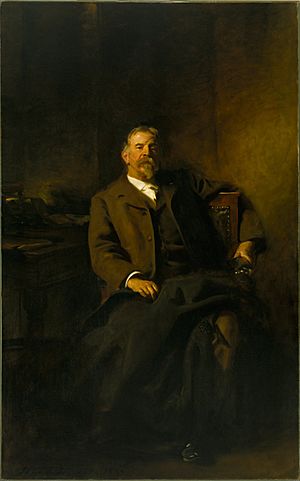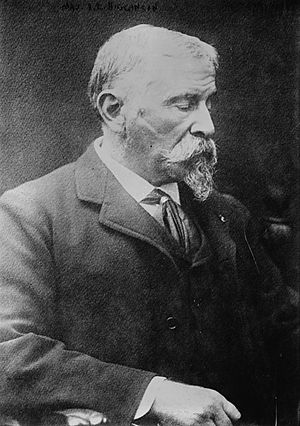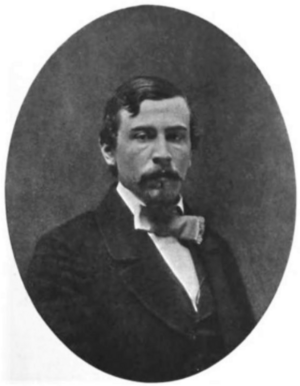Henry Lee Higginson facts for kids
Henry Lee Higginson (born November 18, 1834 – died November 14, 1919) was an American businessman. He is best known for starting the Boston Symphony Orchestra. He also gave a lot of support to Harvard University.
Contents
Henry Higginson's Life Story
Henry Higginson was born in New York City on November 18, 1834. He was the second child of George Higginson and Mary Cabot Lee. His brother was James J. Higginson. He was also a distant cousin of Thomas Wentworth Higginson.
When Henry was four, his family moved to Boston. His father, George, started a business as a junior partner in a brokerage firm. Henry's mother died when he was 15. Henry finished school at Boston Latin School in 1851. He had to leave school twice because of eye problems. He then started at Harvard College, but left after four months due to his eyes. He was sent to Europe to rest.
In March 1855, Henry came back to Boston. His father helped him get a job at a small shipping company. Henry worked there as the only clerk and bookkeeper.
Joining the Army
Henry Lee Higginson joined the Union Army in May 1861. He was a second lieutenant in the 2nd Massachusetts Regiment. He fought in the First Battle of Bull Run. In March 1862, he became a major in the 1st Massachusetts Cavalry.
During the Battle of Aldie in 1863, Higginson was badly hurt. He was knocked off his horse and received three cuts from swords and two gunshot wounds. While he was recovering in Boston, he got married. He married Ida Olympe Frederika Agassiz on December 5, 1863. She was the daughter of Harvard professor Louis Agassiz. They had two children, Cecile Pauline and Alexander Henry.
Even though he later became a colonel in the military, people usually called him "Major." This was to avoid confusion with his older cousin, Thomas Wentworth Higginson, who was known as Colonel Higginson.
His Business Career
After the war, Henry worked for an oil company in Ohio for a few months in 1865. He bought equipment and hired workers for oil fields. In October 1865, he and his friends bought 5,000 acres of cotton-farming land in Georgia. This business failed, and he ended up owing more than $10,000.
Feeling desperate, he started working as a clerk in his father's business, Lee, Higginson & Co., on January 1, 1868. This was a small brokerage firm at the time. He later became a junior partner. His father had been a junior partner since 1858 and worked until he died in 1889. This company eventually became very successful and made a lot of money. Henry Lee Higginson later became the senior partner.
Starting the Boston Symphony Orchestra

On March 30, 1881, Henry Higginson announced his plan for a "Boston Symphony Orchestra" in Boston newspapers. He wanted a full and permanent orchestra that would play the best music at low prices. He wanted it to be like the orchestras in big European cities.
He told his first music director, George Henschel, to hire only local musicians at first. This was to avoid upsetting other musicians in Boston. For the first season, there were 20 concerts. Tickets for the whole series cost $10 or $5. Single tickets were 75 cents or 25 cents. For the weekly afternoon rehearsals, all seats were 25 cents and were not reserved. The concerts were held at the Boston Music Hall. The orchestra also traveled to nearby cities like Providence, Portland, and Worcester. They also played at Harvard University's Sanders Theater. Later, they started selling 505 tickets for 25 cents to people who waited in line before the rehearsal concerts. The orchestra also began touring to farther cities like Philadelphia and New York. Summer concerts started in 1885.
For many years, Henry Higginson was the only person who supported the orchestra financially. He paid for the annual money shortages himself. In one year, he paid as much as $52,000. From the very beginning, he made sure the orchestra had the best conductors from Europe. He also made sure the musicians followed strict rules. In 1882, he made a new contract that said musicians had to be available from Wednesday to Saturday during the season. They could not play in any other orchestra or under any other conductor during those times.
World War I and the Orchestra
During World War I, there was a public disagreement involving Higginson and the orchestra's music director, Karl Muck. Other orchestras were playing the Star-Spangled Banner at their concerts, but the Boston Symphony Orchestra did not. Karl Muck had connections to the German Kaiser, which led to exaggerated news stories. However, Higginson was the main target of criticism. The New York Times called him "stubborn" because he would not let public feelings change the concert programs.
In February 1918, Higginson's money was running low because of the war. He could no longer pay for the orchestra's deficits by himself. He decided to hand over the management of the orchestra to a new group. On April 27, 1918, it was announced that a board of trustees would manage the now incorporated Boston Symphony Orchestra.
Other Important Activities
In 1882, Higginson received an honorary Master of Arts degree from Harvard University. He also became the first president of the new Harvard Club of Boston. During this time, he helped raise a lot of money to send students who needed help to Harvard. He received another honorary degree from Yale University in 1901. He was also the president of the Boston Music Hall and a trustee of the New England Conservatory of Music.
On June 5, 1890, Higginson gave Harvard College a gift of 31 acres of land. He called it Soldiers Field. He gave this land to honor his friends who died in the Civil War. This land later became Harvard's baseball field, where games are still played today.
Henry Higginson cared a lot about education. He believed that education was important to help the country. He felt it was the best way to help people and make sure democracy worked well.
He also helped with other educational efforts. In 1891, Higginson started the Morristown School for young men, which is now called the Morristown-Beard School. He was also a member of the Board of Trustees for Middlesex School. The Higginson House dormitory at that school is named after him.
Later Years
In 1903, Higginson became an early supporter of motor vehicle license plates. He was annoyed by drivers speeding past his summer home without being identified. So, he wrote a petition to the state government. He asked for a law that would require all cars to have state-issued license plates displayed clearly.
On January 25, 1915, Higginson was part of the first telephone call that went all the way across the country. He was on the call with famous people like Thomas A. Watson, Alexander Graham Bell, and President Woodrow Wilson. The telephone Higginson used is now in the Spark Museum of Electrical Invention.
In 1916, he was made an honorary member of the Phi Mu Alpha Sinfonia music fraternity.
Henry Lee Higginson died on November 14, 1919. He was buried in Mount Auburn Cemetery in Cambridge, Massachusetts.
See also
- Karl Muck, conductor, Boston Symphony Orchestra
- Boston Symphony Orchestra



